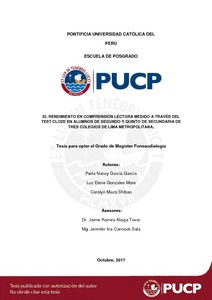| dc.contributor.advisor | Aliaga Tovar, Jaime Ramiro | |
| dc.contributor.advisor | Cannock Sala de Astorne, Jennifer Ina | |
| dc.contributor.author | García García, Perla Nancy | es_ES |
| dc.contributor.author | Gonzales More, Luz Elena | es_ES |
| dc.contributor.author | Miura Shibao, Carolyn | es_ES |
| dc.date.accessioned | 2018-01-16T20:41:30Z | es_ES |
| dc.date.available | 2018-01-16T20:41:30Z | es_ES |
| dc.date.created | 2017 | es_ES |
| dc.date.issued | 2018-01-16 | es_ES |
| dc.identifier.uri | http://hdl.handle.net/20.500.12404/9872 | |
| dc.description.abstract | Este estudio analiza los resultados en comprensión lectora obtenidos por alumnos
de segundo y quinto de secundaria de tres centros educativos, uno estatal, otro
particular y el tercero particular especializado en problemas de aprendizaje durante
el año 2014. La muestra fue de 518 estudiantes (267 de segundo y 251 de quinto
grado; 294 varones y 224 mujeres) quienes respondieron colectivamente a tres
versiones del Test Cloze (Condemarin, Milicic, Neva; 1988) que son: Tradicional,
Maze y Pareo. El rendimiento más bajo se presentó en la modalidad Cloze
Tradicional. La prueba Ji cuadrado de independencia evidenció que no existen
diferencias significativas entre varones y mujeres en el nivel de comprensión
lectora; además, que el grupo de quinto grado tiene un mejor nivel de comprensión
que el de segundo; y por último, que los alumnos del colegio particular presentaron
un mejor rendimiento que el colegio especializado en problemas de aprendizaje y
estos a su vez tuvieron un mejor rendimiento que los alumnos del colegio estatal.
Cabe señalar que las tres versiones del Cloze tienen adecuados índices de
confiabilidad (KR20) y de validez estimada por la intercorrelación de las tres
versiones. Así mismo, se estableció una correlación positiva significativa (p<0.01)
entre el desempeño de los alumnos en las tres pruebas Cloze y una escala de seis
puntos que refleja la apreciación del profesor sobre la comprensión lectora de cada
uno de sus alumnos. | es_ES |
| dc.description.abstract | This research pretended to see if there is any difference about reading
comprehension abilities between secondary students by gender (male/female), by
grade (2nd and 5th grade) and by school type (public school, learning disabilities
school and private school). In addition to that, this investigation analyzed the
reliability and validity of three different versions selected by the researchers of the
Cloze Test: the Traditional, the Maze and the Match version. The group was
integrated by 518 secondary students, where there was 267 second grade students
and 251 fifth grade students; at the same time, in the group there was 294 males and
224 women. In each test, the students had to read different texts and answer them
in order of the three selected versions of the Cloze Test. The results revealed that
the whole group got in a “frustration level” of reading comprehension in the
traditional version, therefore, this version was the most difficult test of the three
selected versions. In the other side, there is no difference by gender, but between
grades, 5th grade of secondary had better results than 2nd grade; and finally, the
private school students had the best performance, then the learning disabilities
school students and, in the last position, the public school students. The three
selected versions of the Cloze had appropriate indexes of reliability (KR20) and
validity, they were estimated by the correlation between the results of the three
versions, and also, supported by a teacher appreciation scale about the reading
comprehension of each student. | es_ES |
| dc.language.iso | spa | es_ES |
| dc.publisher | Pontificia Universidad Católica del Perú | es_ES |
| dc.rights | Atribución-NoComercial-SinDerivadas 2.5 Perú | * |
| dc.rights | info:eu-repo/semantics/openAccess | es_ES |
| dc.rights.uri | http://creativecommons.org/licenses/by-nc-nd/2.5/pe/ | * |
| dc.subject | Procedimiento cloze | es_ES |
| dc.subject | Comprensión de lectura--Evaluación | es_ES |
| dc.subject | Educación secundaria--Investigaciones | es_ES |
| dc.title | El rendimiento en comprensión lectora medido a través del test cloze en alumnos de segundo y quinto de secundaria de tres colegios de Lima Metropolitana | es_ES |
| dc.type | info:eu-repo/semantics/masterThesis | es_ES |
| thesis.degree.name | Magíster en Fonoaudiología | es_ES |
| thesis.degree.level | Maestría | es_ES |
| thesis.degree.grantor | Pontificia Universidad Católica del Perú. Escuela de Posgrado | es_ES |
| thesis.degree.discipline | Fonoaudiología | es_ES |
| renati.discipline | 916117 | es_ES |
| renati.level | https://purl.org/pe-repo/renati/level#maestro | es_ES |
| renati.type | http://purl.org/pe-repo/renati/type#tesis | es_ES |
| dc.publisher.country | PE | es_ES |
| dc.subject.ocde | https://purl.org/pe-repo/ocde/ford#3.05.03 | es_ES |






